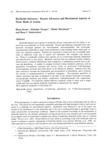Herbicide Safeners : Recent Advances and Biochmical Aspects of Their Mode of Action
JIRCAS international symposium series
| ISSN | 13406108 |
|---|---|
| NII recode ID (NCID) | AA1100908X |

Full text
intlsymp-4_116-123.pdf353.67 KB
Herbicide safeners are a group of chemically diverse compounds with the ability to improve the crop selectivity of certain herbicides. Several agrochemical companies have commercially developed safeners for thiocarbamate, chloroacetanilide, and aryloxyphenoxypropionate herbicides in major monocotyledonous crops including maize, small grain cereals, rice, and grain sorghum. Safeners are employed to extend the use of available herbicides on additional crops and to exploit new herbicides with marginal crop selectivity. There is considerable evidence that safeners act by accelerating herbicide metabolism and detoxification in crop plants. Metabolic reactions that are enhanced include oxidation (hydroxylation, oxidative dealkylation) and conjugation to endogenous moieties such as glucose and glutathione. A number of enzymes involved in these metabolic pathways, such as glutathione S-transferase isozymes and various forms of cytochrome P 450-dependent monooxygenase activities, have been shown to be induced by safeners. Safeners have also been reported to increase the biosynthesis and accumulation of glutathione, and to enhance the process of compartmentation of herbicide conjugates. The botanical specificity of safener protection has been investigated in the light of the recently developed aryloxyphenoxypropionate herbicide and safener combination, clodinafopropargyl and cloquintocetmexyl (Topik®). The herbicide exhibits different metabolic routes in wheat and in target weeds, and only crop specific herbicide metabolism is enhanced by the safener.
® is registered trademark of Ciba-Geigy AG
® is registered trademark of Ciba-Geigy AG
| Creator | Klaus Kreuz Slobodan Farago Shiaki Murakami Hans C. Steinrücken |
|---|---|
| Subject | safener (glutathione S-transferase glutathione cyt P-450 monooxygenase) Topik |
| Publisher | Japan International Research Center for Agricultural Sciences |
| Available Online | |
| Issue | 4 |
| spage | 116 |
| epage | 123 |
| Language | eng |
